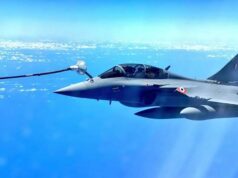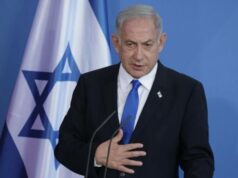India USA Close Friends Based On Equality Only Will Not Join Any Block

US President Donald Trump’s visit to India has underlined two important things. First is the existence of a multi-faceted deep partnership between the two countries based on mutual respect and equality. Second, this partnership is yet to achieve its potential.
For a US president who views international relations as primarily transactional, the speech at the Motera Stadium in Ahmedabad was uncharacteristic of Trump. He emphasised the strategic relationship that Indian and American leaders have sought for years.
At a time when the United States’ relations with many of its allies seem troubled, Washington, even under the Trump administration, continues to signal that New Delhi remains its strategic partner of choice in Asia.
The Trump visit was, as expected, high on pomp, show, and symbolism beginning with the visit to Sabarmati Ashram, Mahatma Gandhi’s abode for decades. It was followed by Modi and Trump’s speeches at Motera Stadium, and then a trip to the Taj Mahal in Agra.
That Trump paid tribute to his friend Modi instead of writing anything about Gandhi in the Sabarmati guestbook reflects his relatively superficial approach. But his Motera speech, written by professionals, highlighted three key aspects of the India-US relationship: shared values, economic potential, and strategic prospects.
The speech was aimed at pleasing an Indian audience with references to the country’s unique experiment with democracy, its economic potential, and its civilisational heritage.
Trump’s references of American support to India to fight terrorism and cracking down on terror organisations operating on the Pakistani border as well as the offer of state-of-the-art defence equipment may be the key takeaways for many.
However, both side would do well to note the fact appeal among most Americans and Indians comes from shared democratic values, secular ethos, and pluralist society.
Those factors have appealed to the American strategic community since the end of World War 2, and are the main reason why India is viewed as a potential US ally.
India-US ties have come a long way in the past 70 years. After independence, Indian preference for non-alignment and American insistence on a formal military alliance prevented closer bonds.
The last four American presidents sought to change that by openly voicing their desire for India as a partner. President Bill Clinton referred to India as the “natural ally” and President George W. Bush’s administration de-hyphenated the India-Pakistan relationship and offered India a standalone civil-nuclear deal.
With a rising China seeking global pre-eminence, the Barack Obama administration spoke of the joint strategic vision with India as a partner in the Asia-Pacific (now referred to as the Indo Pacific). Then-Secretary of State Hilary Clinton even referred to America’s ‘strategic bet’ on India.
A key part of this American policy was the belief that an economically and militarily powerful India was in America’s interest and that the US should, therefore, be willing to ignore the minor disagreements on the economic front (including the issue of trade deficits with India).
While such strategic altruism is missing under Trump, the US’ interest and concerns endure.
The India-US bilateral trade in goods and services stands at $150 billion, a far cry from the desired $500 billion.
Trade, however, has never been easy for the two countries with long-standing disputes related to tariffs, intellectual property rights, agricultural subsidies and data privacy laws.
Trade negotiations are always difficult between two nationalist, populist and protectionist administrations, neither of which wants to be viewed as giving in to the other’s demands.
The American desire to combat the rise of China should translate into helping India’s economic rise but Indian requirements dictates a protectionist trade policy.
Similarly, to achieve its developmental goals as well as global ambitions, India needs to focus on economic growth based on Indian requirements.
For Washington, one of the symbols of a strategic partnership includes a strong defence relationship. The last 15 years have shown the strengthening of a strong defence partnership with India based on military exercises, high-level visits, dialogues like 2 plus 2, and India’s centrality in the Indo-Pacific strategy.
The US is also one of the top three suppliers of defence equipment to India. The two countries signed defence deals worth $3 billion during Trump’s India visit.
These include a $2.6 billion deal for 24 MH-60 `Romeo’ multi-mission helicopters for the Indian Navy and $800 million deal for 6 AH-64E Apache attack choppers for the Indian Army.
Moreover, the US government had also earlier approved the sale of $1.9 billion state-of-the-art Integrated Air Defence Weapon System to India for the modernisation of its armed forces.
India has noted with satisfaction the continued American tilt towards New Delhi and away from Islamabad, something that has continued under the Trump administration.
Still, notwithstanding President Trump’s remarks that Washington is working to ensure a “crackdown on terror organisations that operate on the Pakistani border,” the US does not see India’s immediate neighbourhood the way New Delhi sees it.
The upcoming deal with the Afghan Taliban that Washington aims to sign on 29 February, is an example of how both countries, though strategically more aligned today, still diverge.
New Delhi believes such a deal would only amount to rewarding Pakistan for supporting terrorism and denying India access to Central Asia while bolstering China’s role in that region.
Washington views the rise of China in the Indo-Pacific as separate from what happens in the Middle East or South and Central Asia.
India, however, is concerned not only with the maritime spread of China in the Indian Ocean region but also with Beijing’s deepening presence on the Asian landmass, especially in India’s neighbourhood.
Washington may choose to separate Beijing’s predatory impulses in the South China Sea and the Gulf, Delhi cannot.
Similarly, while the US views India as a potential counterweight to a rising China, it cannot help but notice its unwillingness to exercise hard power or agree to military alliances.
If Delhi seeks global heft, it needs to do more than speak about being a leading power and a global player. This will require critical economic reforms and boosting of military capability as well as demonstrating a grand strategy.
India is a friend of America but not a NATO ally. this has to be understood very clearly by USA. India will not become member of any block as such but will retain its strategic initiative.
The US has historically preferred institutional arrangements for collective security while India refuses collective security mechanism. India has always strived to keep its distance from any formal military alliance or grouping that appears like a military alliance.



